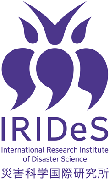Greetings

Takeshi Sato
Chief, International Collaborating Center of Disaster Education Research and Implementation
Professor, International Research Institute of Disaster Science (IRIDeS), Tohoku University
Based on experiences and lessons learned from the 2011 Great East Japan Earthquake and Tsunami, there are strong demands for strengthening disaster education and disaster management at schools in Japan. Among those, strengthening partnerships among schools, households, and community is one of the key indispensable areas to enhancing community resilience. It is thought that Japan is expected to be a leader in developing a model for the collaboration among schools, households, and the communities in the field of disaster education.
Under such circumstances, the International Collaborating Center of Disaster Education would like to contribute to establishing networks among various stakeholders in the field of disaster education. We also would like to advance and spread disaster education efforts by shortening the distance between researchers and practitioners within the Sendai Framework for Disaster Risk Reduction 2015-20130, which was adopted at the 3rd World Conference on Disaster Risk Reduction.

Aiko Sakurai
Deputy Chief, International Collaborating Center of Disaster Education Research and Implementation
Associate Professor, IRIDeS, Tohoku University
In March 2015, the 3rd United Nations World Conference on Disaster Risk Reduction (UNWCDRR) was held in Sendai City, Miyagi Prefecture Japan. At the UNWCDRR, the Sendai Framework for Disaster Risk Reduction (SFDRR) was adopted as the new international framework on disaster risk reduction (DRR) for the next 15 years until 2030. In the SFDRR, disaster risk reduction at educational facilities at a time of disaster is included as one of the global targets for DRR. The Sendai Framework also emphasizes the importance of no disruptions in educational services after disaster, and of public education in the post disaster phase for building back better.
At the areas affected by the 2011 Great East Japan Earthquake and Tsunami, enormous efforts for educational recovery and enhancing disaster risk reduction at schools and communities have been progressing for the last five years. One mission of the International Collaborating Center of Disaster Education is to disseminate and share these experiences and lessons learned with the rest of Japan and the world for mutual learning purposes. Through joint collaborations, the center also aims to expand networks among related agencies and researchers globally in the field of school safety and disaster education. We hope to contribute to the progress of SFDRR through developing a model of disaster education based on GEJET experiences that is applicable to international contexts.



